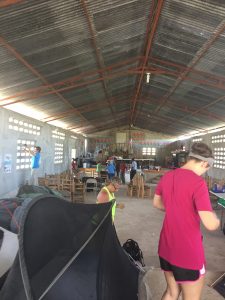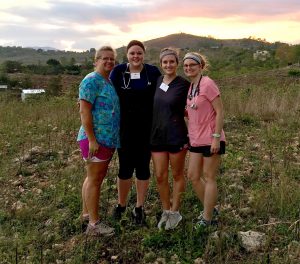Two different worlds: Haiti and America
By: Megan Zuleger,
BSN Class of 2018
Haiti is a life-changing country. From the moment I stepped off the plane, I was immersed in a whole different world. Completely separated from my home country and everything I knew. But it was the beginning of an experience that changed me. An experience I will never forget and cherish for the rest of my life.
The way Haitians live is so different from our own, but they taught me a new appreciation for life. The city of Port-au-Prince was dense. Run down buildings and shacks were compacted together. Garbage piles lined the streets. People crowded the crumbles of sidewalks, selling everything from shoes to clothing, fruits and sugar cane and artwork; anything that could make them a little money. The streets are another story. There are no driving laws in Haiti. No stop signs, no street signs, no speed limits; it is a free-for-all. People pack into vehicles, even on tops of vehicles, fitting more than you would think is possible. Motorcycles weave in and out and in between vehicles; it is not unusual to see six people on a motorcycle, and helmets are a rare sighting. This was my first exposure to Haiti.
 The first night we stayed at Church of the Brethren, which is a guesthouse for mission trip groups. Here we met the group from Olympia, Washington that we would be working with during our week in Grand Boulage. We spent the night playing games and getting to know one another. The next day we traveled up the mountain to our clinical site in Grand Boulage. We were fortunate enough to be driven all the way to our clinical site, but the drive was certainly interesting. This was the first time I had ever experienced mountain driving. The road was curvy, steep and terrifying. I am not afraid of heights, but there were times we were so close to the edge of the cliff that I scooted over more toward the middle of the vehicle so I would not feel so close to the edge. When we got closer to our clinical site, the road conditions deteriorated. We were driving over large boulders and that is when I had a newfound appreciation for car shocks. It was the bumpiest ride I have ever been on. What was even more astonishing was how different mountain living was from the city. In the mountains, buildings and homes are sporadic and not compacted together. People are dispersed and travel in small groups or with animals. The mountains were so peaceful and had so much room to breath. Once we reached the clinical site, we helped set up the rest of clinical and our living area. That afternoon we got to experience the flow of clinic for the first time. We saw about 95 people that afternoon. This is the point in which I got to experience first hand the many health complications Haitians have.
The first night we stayed at Church of the Brethren, which is a guesthouse for mission trip groups. Here we met the group from Olympia, Washington that we would be working with during our week in Grand Boulage. We spent the night playing games and getting to know one another. The next day we traveled up the mountain to our clinical site in Grand Boulage. We were fortunate enough to be driven all the way to our clinical site, but the drive was certainly interesting. This was the first time I had ever experienced mountain driving. The road was curvy, steep and terrifying. I am not afraid of heights, but there were times we were so close to the edge of the cliff that I scooted over more toward the middle of the vehicle so I would not feel so close to the edge. When we got closer to our clinical site, the road conditions deteriorated. We were driving over large boulders and that is when I had a newfound appreciation for car shocks. It was the bumpiest ride I have ever been on. What was even more astonishing was how different mountain living was from the city. In the mountains, buildings and homes are sporadic and not compacted together. People are dispersed and travel in small groups or with animals. The mountains were so peaceful and had so much room to breath. Once we reached the clinical site, we helped set up the rest of clinical and our living area. That afternoon we got to experience the flow of clinic for the first time. We saw about 95 people that afternoon. This is the point in which I got to experience first hand the many health complications Haitians have.
 Every day in the clinic we got to work at different stations. We rotated doing vitals, tonometer checks for glaucoma, deworming children and obtaining weights, and being a runner for providers. MacKayla, Abbey, and I each got to go on a home visit and I got to go to a school. We got to see a lot of babies and small children throughout the clinic. Some of the major health complications we saw were hypertension, glaucoma, malnourishment and burns. I could not believe some of the blood pressure readings we recorded. The highest blood pressure I took manually was 240/140. I was astonished that this lady was standing and talking with us. It was also very heartbreaking to see the amount of malnourishment. We had babies who were 3-12 months old and only weighed five pounds and elderly women who weighed 60-70 pounds. This was very difficult to see. Even though we saw some pretty devastating health states, we had the pleasure of seeing a new life begin. I was lucky enough to help deliver a baby in the clinic! It was such an amazing experience to help bring a new life into this world!
Every day in the clinic we got to work at different stations. We rotated doing vitals, tonometer checks for glaucoma, deworming children and obtaining weights, and being a runner for providers. MacKayla, Abbey, and I each got to go on a home visit and I got to go to a school. We got to see a lot of babies and small children throughout the clinic. Some of the major health complications we saw were hypertension, glaucoma, malnourishment and burns. I could not believe some of the blood pressure readings we recorded. The highest blood pressure I took manually was 240/140. I was astonished that this lady was standing and talking with us. It was also very heartbreaking to see the amount of malnourishment. We had babies who were 3-12 months old and only weighed five pounds and elderly women who weighed 60-70 pounds. This was very difficult to see. Even though we saw some pretty devastating health states, we had the pleasure of seeing a new life begin. I was lucky enough to help deliver a baby in the clinic! It was such an amazing experience to help bring a new life into this world!
 MacKayla, Abbey and I had so many new experiences that helped us grow personally and professionally. We got to work alongside translators and a whole medical team we did not know. In Haiti, we are the minority. We got to experience what it was like to not understand their language and the barrier that creates in providing medical treatment. We got to experience the Haitian culture. One of the translators, in particular, spent a lot of time with us teaching us about their culture. He taught us how to Compa, which is a Haitian dance similar to salsa dancing. He took us to “the source,” which is a two-mile trek down into the mountain where the locals get their water. He definitely helped us get the full Haitian experience.
MacKayla, Abbey and I had so many new experiences that helped us grow personally and professionally. We got to work alongside translators and a whole medical team we did not know. In Haiti, we are the minority. We got to experience what it was like to not understand their language and the barrier that creates in providing medical treatment. We got to experience the Haitian culture. One of the translators, in particular, spent a lot of time with us teaching us about their culture. He taught us how to Compa, which is a Haitian dance similar to salsa dancing. He took us to “the source,” which is a two-mile trek down into the mountain where the locals get their water. He definitely helped us get the full Haitian experience.
Besides the cultural aspect of Haiti, the views were astonishingly breathtaking. The sky in Haiti is not like the sky here. The blue is so blue. The clouds pop out like you could reach out and touch them. The rolling hills in the mountainsides were so defined it was unbelievable. The sunrises and sunsets were nothing like I have seen before. It was so peaceful and calming. Every day I could not believe how beautiful Haiti is.
 One of the biggest takeaways I got from Haiti, besides the skills and culture, was the connectedness with the locals and our team. After clinic, we all got to spend time with the locals dancing, playing soccer or having a music party. Our Grand Boulage team became a family to me, and that is something I will cherish forever. We worked together to help make the lives of Haitians a little better. All my life I have wanted to make a difference in this world, but no matter what I did, I felt like I was not making an impact on anyone. My trip to Haiti completely changed that. I now feel like I made a difference in this world and I cannot wait to go back again and make more friends and help out more people. I am so grateful my first experience in Haiti was with the Olympia team along with MacKayla, Abbey, and Kathie. The friendships we made will last a lifetime. I am very grateful for this opportunity I had. It was a life-changing experience for me and I cannot wait to do it all over again.
One of the biggest takeaways I got from Haiti, besides the skills and culture, was the connectedness with the locals and our team. After clinic, we all got to spend time with the locals dancing, playing soccer or having a music party. Our Grand Boulage team became a family to me, and that is something I will cherish forever. We worked together to help make the lives of Haitians a little better. All my life I have wanted to make a difference in this world, but no matter what I did, I felt like I was not making an impact on anyone. My trip to Haiti completely changed that. I now feel like I made a difference in this world and I cannot wait to go back again and make more friends and help out more people. I am so grateful my first experience in Haiti was with the Olympia team along with MacKayla, Abbey, and Kathie. The friendships we made will last a lifetime. I am very grateful for this opportunity I had. It was a life-changing experience for me and I cannot wait to do it all over again.


